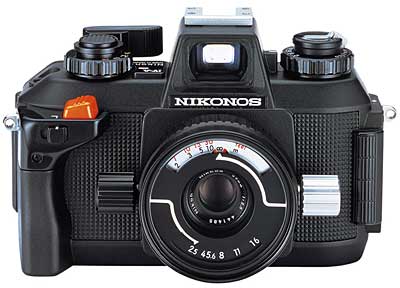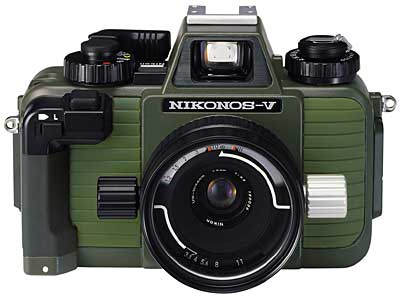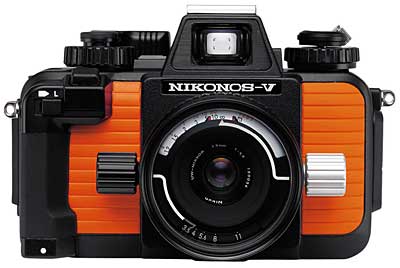|
||||
|
||||
1992年4月推出的世界第一台单反式可更换镜头水下照相机。
|
|
一提起水下相机,会令不少人联想到Nikon的Nikonos V水下相机。这几年来不少厂家都生产了不少防水或潜水相机,但纵观多年来的相机市场,可更换镜头的水下相机也只有Nikon的产品,因此Nikon的水下相机一直畅销不衰。但再仔细地看看各类产品,不难发现所有的水下相机都是旁轴平视取景的(Nikonos V亦不例外),并没有单反式的水下相机存在。
 |
 |
 |
Nikon终于于1992年4月生产了世界上第一架单反式的水下相机Nikonos RS,这架相机不仅跳过了单反式取景这一阶段,而且一步直接进入自动聚焦阶段,足令热衷于水下摄影的人士狂喜不已。
Nikonos RS不仅是世界上第一架水下单反机,而且还是世界上第一架水下AF单反机。它的AF系统与陆上的F-601的一样,采用了高级AM200检测组件,AF检测范围低端达EV-1,对在亮度极低的水下摄影极为有利。Nikonos RS的AF方式有三种:单次AF、连续AF和陷井聚焦,它是Nikon第一架机身内置陷井聚焦方式的相机,以前所有Nikon AF单反机中有些要加入多功能控制机背才具有这一方式,相信陷井聚焦方式在水中摄影是很有用的。在连续AF方式下,Nikonos RS还有焦点预测,令聚焦更为准确。另外一点不同的是,Nikonos RS并没有手动聚焦方式,而是改成电动聚焦。在水中,电动聚焦方式要比手动旋转聚焦环来得方便,而且从镜头制造工艺来讲,由于取消了聚焦环,还能更容易制成防水的。就聚焦系统而言,Nikonos RS是NikonAF单反机中方式最多的,因此也可以说是最好的。
在测光系统中,Nikonos RS不例外地装入了矩阵式测光方式,这种方式的可靠性已被时间和实践所证明。当采用手动曝光补偿时,会自动地改成中央重点加权平均测光方式。
Nikonos RS的曝光方式并不多,只有光圈优先自动曝光和手动曝光两种方式,这已经足够用了。快门速度为1/2000-1秒,外加B门和可达±2EV的曝光补偿,完全可以应付水中摄影的各种场合。
Nikon还专门为Nikonos RS生产了一支专用闪光灯SB-104,指数为16米,有TTL闪光灯控制、自动闪光、手动闪光和后帘同步等方式。另外还配有SK-104W和SK-104E等闪光灯支架,使在水中布光更为方便。
Nikonos RS的外形设计非常奇特,机身采用流线型设计自不待言,其取景器最为新颖,取景器的光轴不再与镜头光轴平行,而是向上倾斜9°,而且远视点达60毫米之多。这一切都是针对水中摄影的特殊情况而特别设计的,因为在水中,摄影师都是戴着潜水镜的。另外各种调节旋钮都比一般单反机的要高许多,在水中既使戴着手套也能方便地调节各种参数。相机机身采用铜铝合金制造,因此特别重,达2060克,幸好这架相机是在水中使用,由于水的浮力,重量只有920克左右。Nikonos RS所有的封口均采用”O”形橡胶密封,加上双重机背,故每平方厘米可承受10公斤的压力,可在水下100米处工作。
与Nikonos RS配套的镜头有4支,其中R-UW20-35/2.8是世界上第一支水下变焦镜头;而R-UW50/2.8也是世界上第一支微距镜头,最大放大倍率为1:1;第三支则是R-UW28/2.8。由于水中光线的折射率与地面的不同,这三支镜头分别相当于地面的24-50毫米变焦镜头、70毫米和35毫米镜头。
<next page>
|
R-UW AF 20-35/2.8 |
R-UW AF 28/2.8 |
|
R-UW AF 50/2.8 Micro |
R-UW AF 13/2.8 |
从整体来看,Nikonos RS是设计非常精良的相机,在潜水相机类中一支独秀,没有任何一架能与之相比。在AF时代初期,Nikon公司一直持稳健的姿态。但进入90年代后,也许意识到这种姿态对自己的发展不利,因此Nikon在启用新技术上也采用了积极的做法,我们从Nikonos RS就能看出这一迹象。按常规而论,Nikon应该先推出单反式的手动聚焦水下相机,继而推出AF水下单反机。Nikon一下就跳过了手动聚焦这一阶段,初看起来似乎是很大胆,但陆上AF单反机多年来的发展,已经证明了自动聚焦技术是非常成熟的,因此在90年代推出这架水中AF单反机则是顺理成章的。相信Nikonos RS将在市场上流行很长一段时间,成为水中相机的“王中之王”。
Nikonos RS规格指标
|
Type of camera: |
Integral-motor autofocus, 35mm single-lens reflex underwater camera |
|
Construction: |
Body made of die-cast copper silumin oxidised aluminium alloy; all joints sealed by O-ring gaskets to ensure an absolute watertight environment; camera able to withstand pressures to a depth of 100m (328 ft.) |
|
Picture format: |
24mm x 36mm (standard 35mm film format) |
|
Lens mount: |
Nikonos R-UW mount |
|
Lens: |
Dedicated R-UW AF Nikkor lenses having CPU contacts |
|
Viewfinder: |
Fixed eyelevel pentaprism high-eyepoint type; offset angle 9? 0.39x magnification with 28mm lens at infinity; 92% frame coverage; -0.7 diopter; 60mm (2.4 in.) eyepoint relief |
|
Focusing screen: |
Fixed Nikon advanced B-type Brite View screen with central focus brackets for autofocus operation |
|
Viewfinder information: |
The following LCD indications appear: focus indicators, exposure mode, shutter speed, aperture, film speed, DX mark, ISO mark, electronic analogue display, exposure compensation mark, over or underexposure alert, ready-light; illuminated while meter is ON |
|
Film speed range: |
ISO 25 to 5000 for DX-coded film; ISO 6 to 6400 for manual setting |
|
Film speed setting: |
At DX position, automatically set to ISO speed of DX-code film used; with non-DX-coded film, ISO speed is set manually |
|
Film loading: |
Film automatically advances to first frame when shutter release button is depressed once |
|
Film advance: |
Film automatically advances one frame when shutter is released |
|
Frame counter: |
Additive type; counts back while film is rewinding; illuminated by LED |
|
Film rewind: |
Automatic when film rewind lever is turned; approx. 25 sec. per 36-exposure roll; stops automatically when film is rewound |
|
Focus modes: |
Single-Servo or Continuous-Servo autofocus, Power Focus and Freeze Focus |
|
Autofocus detection system: |
TTL phase detection system using Nikon Advanced AM200 autofocus module |
|
Autofocus detection range: |
Approx. EV minus 1 to EV 19 (ISO 100) |
|
Autofocus lock: |
By lightly pressing shutter release button in Single -Servo autofocus |
|
Focus tracking: |
Automatically activated in Single-Servo and Continuous-Servo autofocus |
|
Electronic rangefinder: |
Available in Power Focus mode |
|
Exposure metering: |
Matrix and Centre-Weighted Metering built-in |
|
Exposure meter: |
Activated by lightly pressing shutter release button; stays on for approx. 16 sec. after finger is lifted off the button |
|
Metering range: |
EV3 to EV20 (ISO 100) |
|
Exposure modes: |
Aperture-priority auto (A) and manual (M) |
|
Aperture-priority auto exposure control: |
Shutter speed automatically set to match manually selectable aperture |
|
Manual exposure control: |
Both aperture and shutter speed are set manually |
|
Exposure compensation: |
Possible using exposure compensation dial within ? EV range in 1/3 EV steps |
|
Shutter: |
Electromagnetically controlled vertical-travel focal-plane shutter |
|
Shutter speeds: |
Lithium niobate oscillator-controlled speeds from 1/2000 to 1 sec.; electromagnetically controlled long exposure at B setting |
|
Reflex mirror: |
Automatic, instant-return type |
|
Camera back: |
Hinged type; opened and locked via camera back lock/release latch; inner camera door is also provided |
|
Flash sync.: |
1/30 to 1/125 sec. in A mode, down to one sec. shutter is available in rear-curtain sync; in M mode, shutter fires at speed set, and when set from 1/250 sec. or higher, shutter is automatically set to 1/125 sec. |
|
Flash sync control: |
Front-curtain sync and rear-curtain sync provided; selected via switch inside body |
|
Flash ready-light: |
Viewfinder LED lights up when dedicated Nikonos Speedlight is ready to fire; blinks to warn of insufficient light for correct exposure |
|
Power source: |
One 6V lithium battery pack (CR-P2 or DL223A) |
|
Tripod socket: |
Located at base plate of camera body; standard 1/4 in. (JIS) |
|
Terminals: |
Accessory shoe, flash sync socket, remote socket |
|
Dimensions ( |
WxHxD): 196 x 151 x 85mm |
|
Weight (body only): |
2,130g, 920g underwater |
<next page>
|
|
|
|
|
|
|
|
|
<next page>
|
|
|
|
|
|